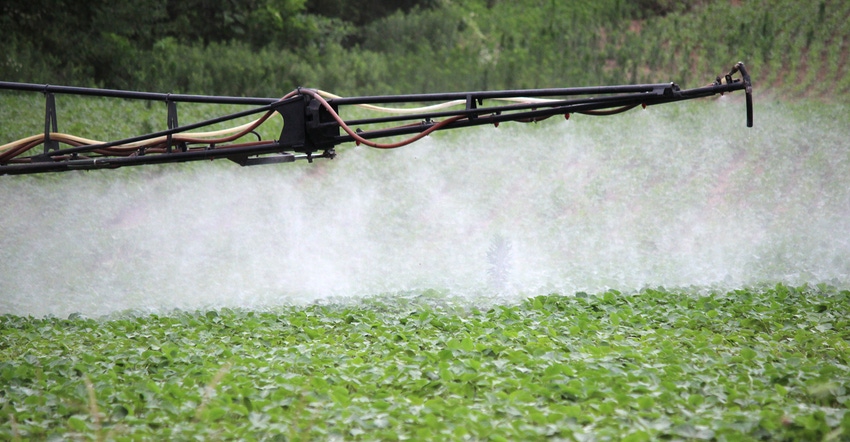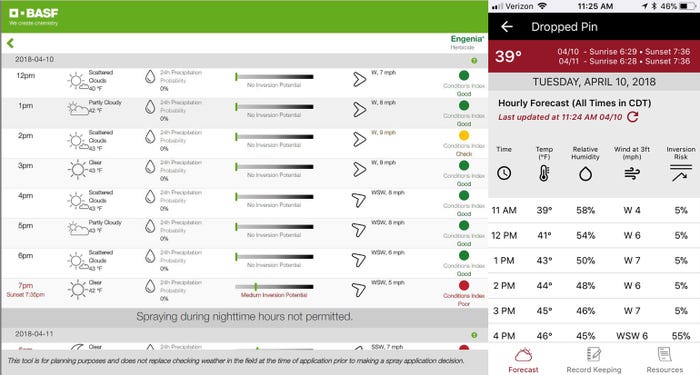
With label approval beyond 2018 riding on keeping dicamba herbicides in check this season, Monsanto and BASF have rolled out new tools to help applicators navigate the complicated weather-related XtendiMax and Engenia label requirements.
But the tools are for application planning, not decision-making — meaning they’re not for in-field use. EPA labels require dicamba applicators to monitor wind speed at boom height during application and prohibit applications during temperature inversions.
Ryan Rubischko, Monsanto’s North America dicamba portfolio lead, says the new RRXtend app identifies potential application windows based on forecast weather conditions, but it shouldn’t be used for final application decisions.
The same applies for BASF’s mobile-friendly website, says Nathan Borgmeyer, senior marketing manager. The free tool, available at engeniastewardship.com, does not replace the label’s required in-field weather observations. Borgmeyer says the tool only offers predicted wind speeds at boom height, not measured wind speeds. He adds that actual field conditions can vary, and applicators still must check weather conditions in the field at application.
Both tools from Monsanto and BASF convey information based on federal label requirements, so applicators should refer to state labels for additional restrictions, including reduced spraying hours and temperature cutoffs.
 ACTUAL CONDITIONS MAY VARY: The two companies’ tools use different weather models and produce different wind speed results. (Note the 2 p.m. forecast wind speed for the same location.) “As with any weather models and predictions, actual field conditions can vary,” says Nathan Borgmeyer, BASF. “For that reason, growers and applicators should use the tool for planning purposes and should always check weather conditions in the field at the time of application.”
ACTUAL CONDITIONS MAY VARY: The two companies’ tools use different weather models and produce different wind speed results. (Note the 2 p.m. forecast wind speed for the same location.) “As with any weather models and predictions, actual field conditions can vary,” says Nathan Borgmeyer, BASF. “For that reason, growers and applicators should use the tool for planning purposes and should always check weather conditions in the field at the time of application.”

Monsanto’s app
Monsanto features three key resources in its RRXtend app:
1. Weather. See field-level-specific hourly forecasts for the next 16 hours, including temperature, relative humidity, wind speed and direction, and inversion probability risk. The app sources weather data from the National Oceanic and Atmospheric Administration and its own Climate Corporation models. From there, it employs extra math. Weather stations typically forecast wind speed and direction at 33 feet, far above boom height. To comply with the label requirements, Rubischko says Climate Corp. uses a proprietary algorithm to predict wind speed and direction at boom height.
2. Record keeping. After creating a profile, app users can fill out the mandatory record-keeping documentation, and then save, export or store the documentation on their mobile device. Monsanto says the information is not shared beyond the app.
“From a privacy standpoint, all information entered is stored within the phone,” Rubischko says.
3. Application resources. If farmers need a last-minute refresher on dicamba training, the app offers links to training information, approved tankmix and nozzle lists, and educational videos.
As of early April, Rubischko says more than 10,000 individuals had downloaded the free RRXtend app, available in the Apple App Store or on Google Play.
BASF’s website
On its website, BASF uses a “blending of different weather forecasts” from NOAA to indicate poor, good or marginal local application conditions based on a phone’s location services, a desktop’s IP address or entered field locations.
The weather forecast includes:
1. inversion potential based on temperatures at ground level and 2 meters above the ground
2. precipitation probability for the next 24 hours
3. time of sunrise and sunset, including a reminder that no nighttime spraying is permitted
4. predictions on hourly temperatures, cloud cover, wind speed and wind direction for the next 36 hours
BASF does not view its new tool as a record-keeping or compliance tool, Borgmeyer says. “As this is a planning tool, we do not use it to capture information to utilize in any alleged off-target incidences.”
About the Author(s)
You May Also Like




